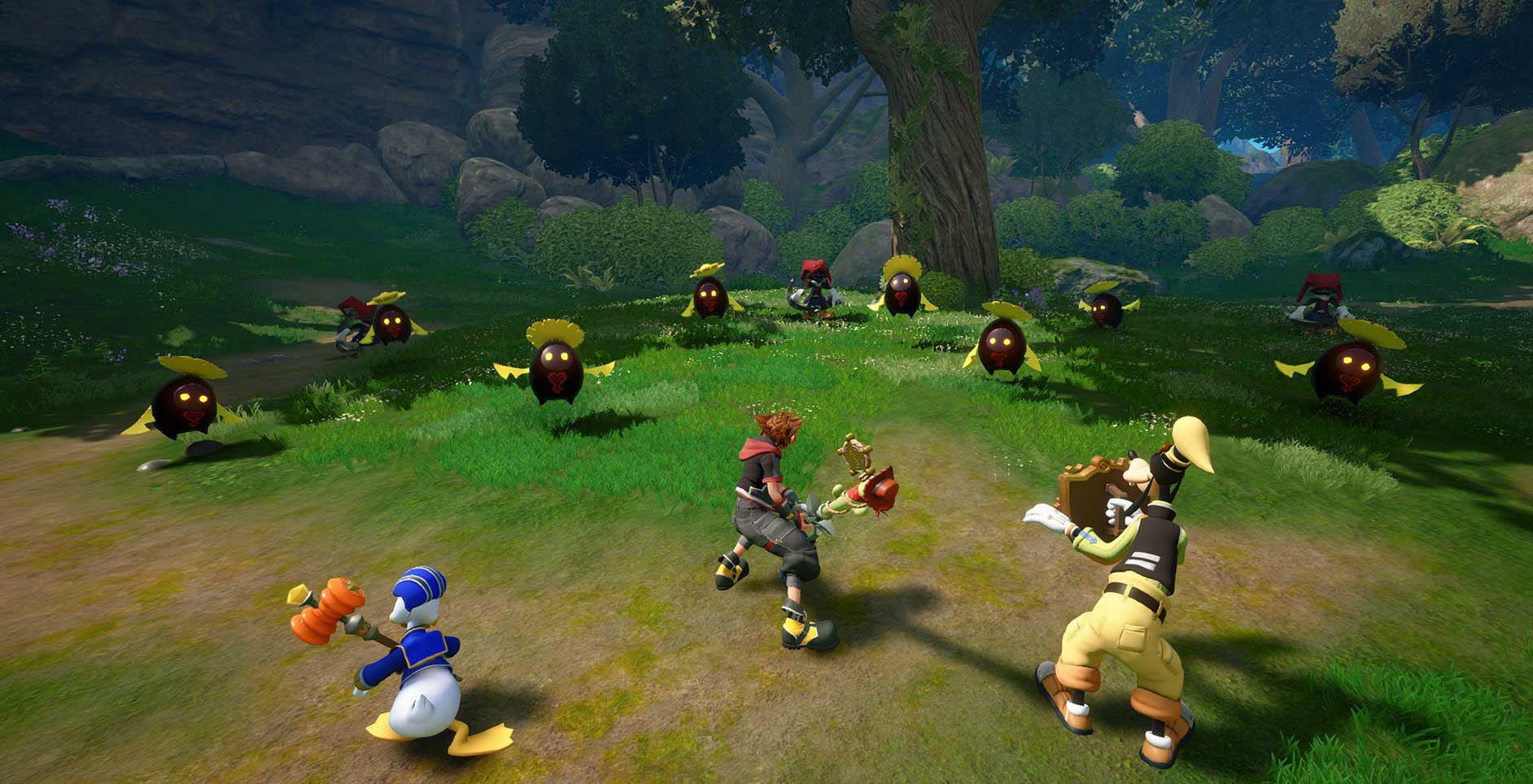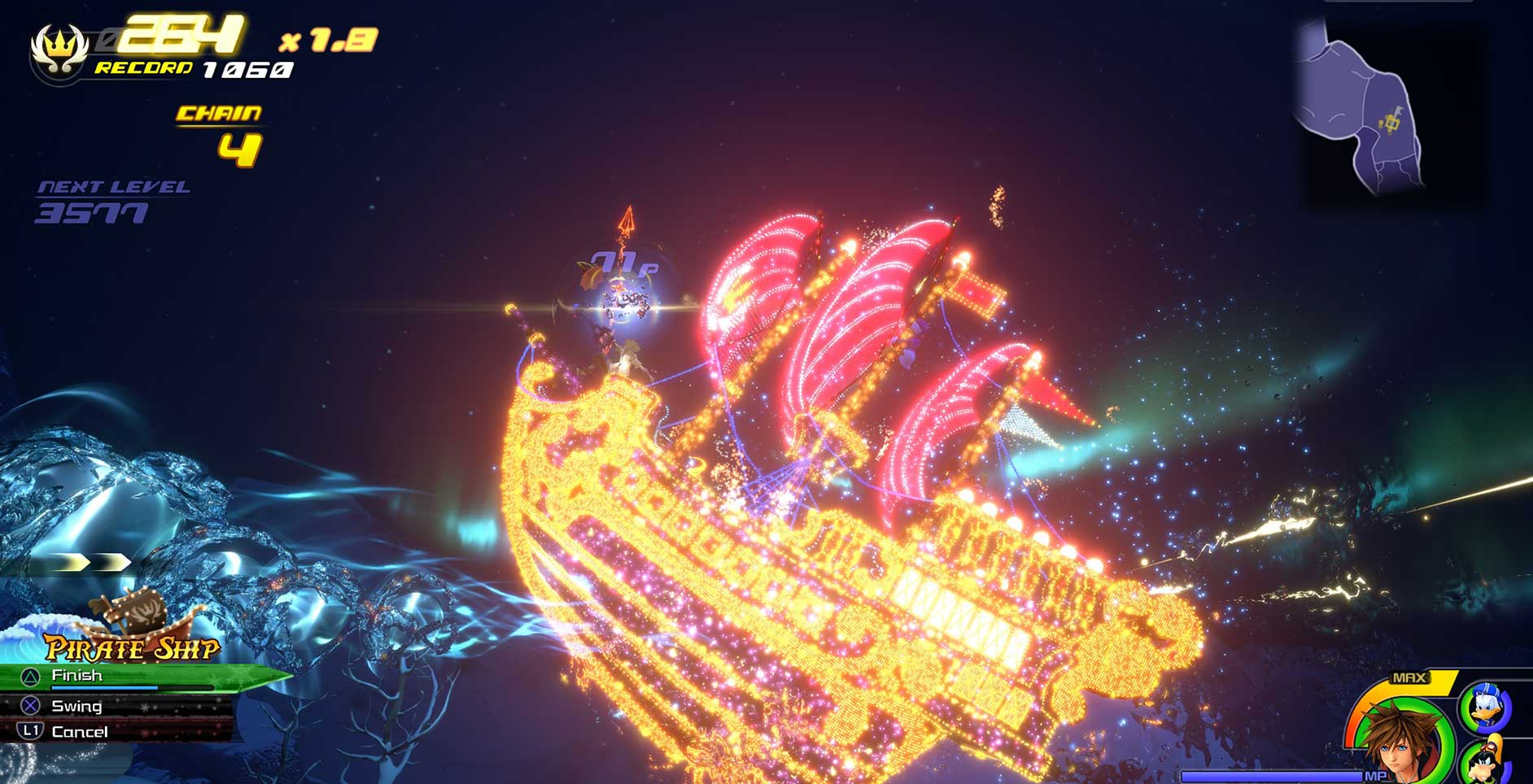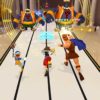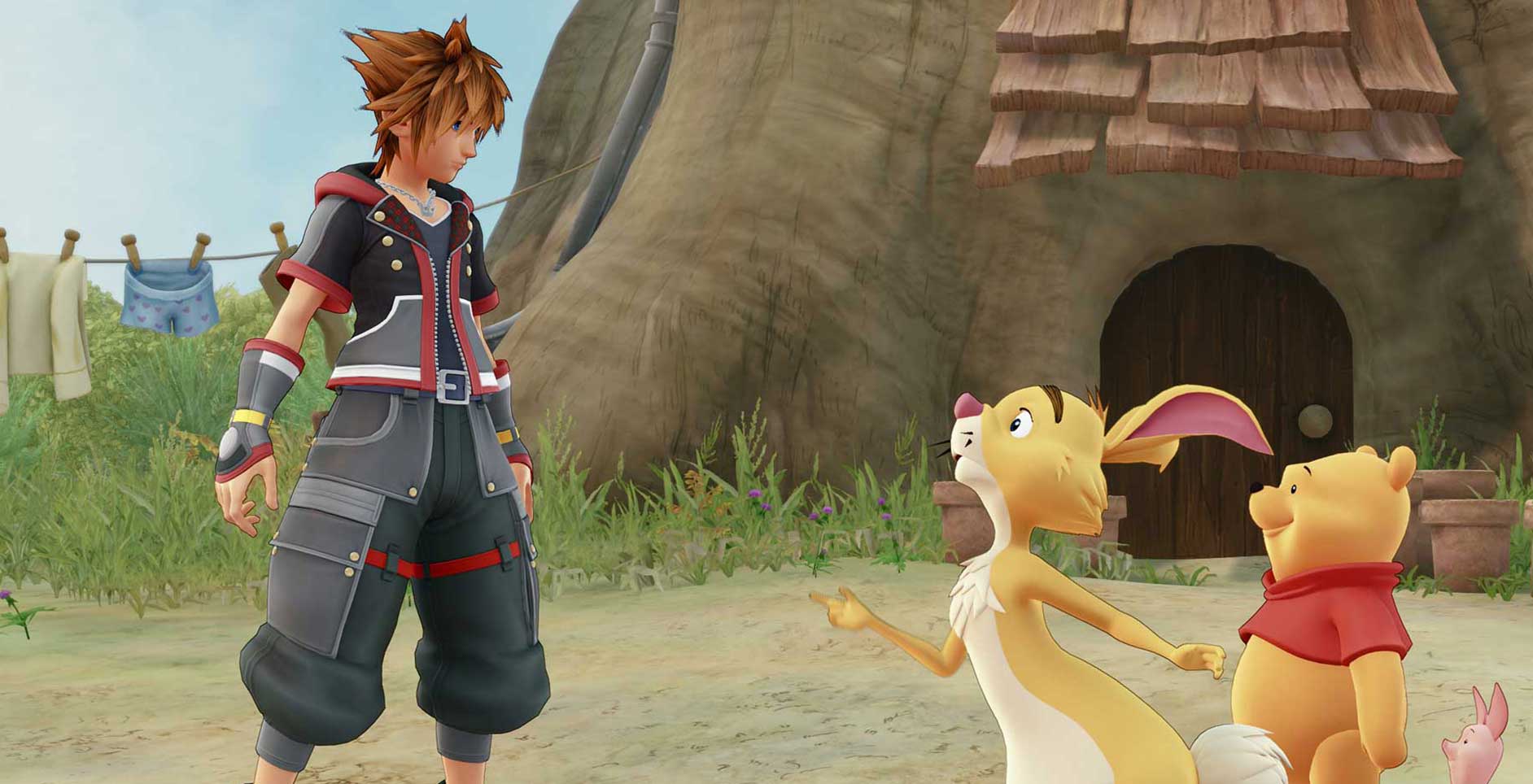There’s a moment in every Kingdom Hearts fan’s life when they realise that, despite their best efforts, they no longer have any idea what’s going on the in long-running series’ famously convoluted story. Whether you only ever played the two main, numbered entries on the PlayStation 2 or you’ve also played the many spin-offs and the F2P mobile game, there’s a point where there’s no choice but to throw both hands up in defeat and admit that you’re completely lost. For me it was somewhere around the Coded/Dream Drop Distance era, where folks started bouncing around virtual worlds and jumping into each other’s dreams Inception-style. Even before then I’ll admit I occasionally found it hard to remember which one of the many identical-looking characters was which at any given moment. So, despite going back and replaying most of the titles in the recent HD collections and watching countless YouTube recaps in preparation, I went into Kingdom Hearts III concerned that I’d wind up totally perplexed within hours of starting the game. Thankfully though, that wasn’t the case.
Against all odds, Kingdom Hearts III features a story that is fairly welcoming to casual fans and even newcomers. Without ever shying away from its past and the tangled web of heroes, anti-heroes, döppelgangers, time travel, black cloaks and anime hair that precedes it, the vast majority of the game’s story is a return to the themes and messages of the very first title. There’s a concerted effort here to put the spotlight back on Sora and his friends and revisit matters of the heart, of companionship and emotional strength that were at the core of the allegorical and symbolic imagery that the series was founded on. Without delving too far into the series’ lore, Kingdom Hearts III picks up after Kingdom Hearts 3D: Dream Drop Distance and sees Sora, Donald and Goofy continue on their quest to assemble the seven Guardians of Light and prevent a new iteration of the nefarious Organisation XIII from unlocking Kingdom Hearts, the heart of all worlds, and reshaping all existence as they see fit. At the game’s opening, Sora is still dealing with having failed the Mark of Mastery exam needed to become a true Keyblade Master, knowing that he needs to find it within himself to pass so that he can join his friends in defeating the Organisation. To that end, the crux of the game’s plot is about Sora’s personal journey, hopping from world to world with Donald and Goofy in tow to learn as much as he can about matters of the heart and his own inner strength from a menagerie of Disney film characters.

When it comes to the locales that the three traverse on their character-building journey, Kingdom Hearts III actually features a fairly modest eight worlds based on Disney properties. The limited selection is a small price to pay though for the sheer size and depth of most of them. Where the worlds in previous games often felt like Disney-themed dioramas, all bite-sized spaces broken up by loading screens, this time around they’re huge environments that actually feel convincingly like places from the franchises they’re based on. Every world has a distinctly different feel as well, often each with a unique structure and bespoke mechanics and minigames. Some worlds are fairly linear in form, like the corridors of the Monsters Inc facility in Monstropolis, while others are open, free-roaming spaces like Big Hero 6’s San Fransokyo. Each world represents around two or three hours of main story content, ignoring time taken to poke around their various corners to look for treasures and secrets. As with earlier games the short-form stories featured in each world serve a handy dual purpose of pushing the overall plot and Sora’s character arc along while serving up smaller, self-contained narratives that are satisfying to see through and don’t require a PhD to understand. It’s a hook that’s worked perfectly in prior titles and in Kingdom Hearts III it feels more important than ever, considering this might be a lot of players’ first Kingdom Hearts game since the PlayStation 2, or ever. The other benefit to this structure is that the worlds are folded quite neatly into the Kingdom Hearts lore, with Organisation XIII sharing an almost parallel journey to Sora’s, in which they’re travelling these same worlds with the intent of learning about the characteristics of the various Disney luminaries’ hearts.
Returning from previous entries are worlds based on Hercules, Pirates of the Caribbean and Winnie the Pooh, while the rest all represent debut appearances. Of the new additions, the Tangled and Frozen worlds were unexpected stand-outs for me. Both act like abridged versions of their respective films, mirroring the storylines and completely recreating many of the pivotal scenes in-engine, with the addition of Sora and company. Having Final Fantasy-esque characters navigate environments skinned to look like beloved Disney films is one thing, witnessing Idina Menzel’s performance of “Let It Go” in Frozen play out in full with the addition of Sora, Donald and Goofy is something else entirely. The most disappointing of the bunch, both in terms of content and the fact that I was super hyped for it, is the Monsters Inc world, Monstropolis. What sounds like it could be a potentially awesome jaunt through the monster world from the iconic Pixar films winds up being a dull trek through identical-looking corridors and rooms in the Monsters Inc facility that features almost none of the charm and unique diversions that make the other worlds great. On the other end of the spectrum, though I have no interest in the franchise (for various reasons), the Pirates of the Caribbean world is hands-down the best. Without saying too much and ruining the fun, it draws heavy influence from other games about pirates and pirate-y activities and almost feels like its own, smaller game.

Of course it wouldn’t be a Kingdom Hearts game if getting from world to world didn’t involve piloting a gummi ship, and these sequences see a similar update to a more free-form and exploratory format. Instead of dropping the gummi ship in standalone shmup-style levels inbetween worlds, the game features a handful of large, open expanses of space in which to fly with complete freedom. Each pocket of space is home to two or three of the game’s worlds, and flying between them involves dodging asteroids, collecting items and gummi ship upgrades and occasionally entering battles that play out much like Kingdom Hearts II’s gummi ship sequences. As before, there’s a gummi garage in which to build and customise ships from scratch or from templates found and bought throughout the game.
These systems work much the same way as before, albeit far friendlier to navigate and with significantly more options for cosmetic customisation than before. As with most of the game’s diversions, there’s a huge temptation to just while away hours on end building ships and levelling them up to collect resources for building even better ships. In fact, between this and a lot of the game’s other side content my chances of getting this review out in a timely manner were almost dashed on multiple occasions. Thankfully though, the game never feels bloated or overstuffed with content, mostly because there’s rarely any feeling of missing out or being underprepared for ignoring content that doesn’t immediately spark joy.

It almost goes without saying given its pedigree but Kingdom Hearts III is a stunning game to behold. The simplistic, yet visually engaging designs from Nomura and his team alongside iconic Disney imagery have always made for great-looking games that hold up even today, but the jump to the current generation of consoles brings with it some of the richest and most beautiful views in modern gaming. Each world has a distinct look, and the game often tailors its own visual rendering to match. Visit Winnie the Pooh in the 100-Acre Wood and you’ll find Sora and friends adopt a cel-shaded look that fits in with that world’s vibe, or sail the high seas alongside the Black Pearl in the scarily realistic looking Pirates of the Caribbean world and you’ll see just how far the game’s artists have gone to make everything feel as faithful to the source material as possible while still being consistent with the overall look. Animations in particular are superb, and although from a technical perspective the effects of its lengthy development period can be seen in the odd rough edge, the attention to detail and staggering number of incidental flourishes throughout make for a truly impressive whole.
The audio work is equally top-notch, with series veteran composer Yoko Shimomura handing in a beautiful score with some amazing orchestral renditions of the Disney franchises’ notable themes. Voice acting is also great across the board, and although the mix of original voice actors and moderately convincing stand-ins for the Disney characters will always be ever-so-slightly disappointing, it’s the most convincing the series has ever been. Though the game’s many cutscenes, especially the ones that bookend each world, continue series tradition in being overly long and wafty affairs, they’re all so beautiful that they easily command my undivided attention. Like my childhood self constantly resetting my PS2 to see the original game’s CG intro over and over, I’ve jumped into the handy Theatre menu more times than I can count to watch the new one featuring the banger of a Skrillex and Utada Hikaru song, Face My Fears. Chills, every time.

That same penchant for being unabashedly ostentatious extends to the game’s combat, which is probably the biggest example of the excess that Kingdom Hearts III revels in. Building on the already over-the-top battles of the previous games, the newest chapter kicks things up about ten notches, then carves in another twenty new notches and kicks it up those as well. Each encounter starts off familiarly enough, with Sora jumping and dashing around, throwing out Keyblade combos and magical spells, but things tend to escalate from there pretty quickly. Drawing on mechanics added and updated in more recent titles Kingdom Hearts: Birth By Sleep, Kingdom Hearts 0.2: Birth By Sleep – A Fragmentary Passage and Dream Drop Distance, there is a veritable smörgåsbord of abilities and special attacks for Sora to make use of in battle. Beyond the usual attacks and magic, Sora has access to summons, team attacks, flowmotion moves, a homing projectile ability, contextual actions, weapon abilities and even a range of special moves based on Disney theme park rides dubbed Attractions. That last one in particular adds a huge degree of spectacle and extravagance to battles, activating after Sora lands a blow on a randomly highlighted enemy and summoning a ride appropriate to the situation. The rides themselves act almost like minigames with their own unique controls and mechanics, like bouncing around the battlefield in the Mad Tea Cups or timing button presses to a spinning carousel to send out deadly shockwaves. The game even tracks combos and scores while using these abilities, keeping the rides interesting even after the 100th time you’ve been on them.
The most significant new wrinkle in combat though is the Formchange system, a combination of sorts of Kingdom Hearts II’s Drive Forms and Birth By Sleep’s Command Styles. Each new Keyblade that Sora collects in his travels has the ability transform, gaining more power and sometimes even switching up the playstyle slightly. Activating these transformations is simply a matter of building up and maintaining a gauge through attacking, which gives incentive to keep the pressure up and the combos flowing in battle. Those who prefer wielding magical spells aren’t left in the dust either, as contributing to the majority of the gauge with a particular spell instead grants the ability to use Grand Magic, a souped-up version of that spell, once for free. The reason this mechanic works so well is it works in tandem with all of the other abilities in giving each fight an exciting crescendo that seamlessly builds on each individual’s playstyles. Even the most pedestrian of encounters with Heartless or Nobody enemies regularly escalates from simple hacking and slashing to a rapid succession of increasingly over-the-top assaults. Purists might lament the distilling of the game’s challenge in favour of extravagance, but for those people there’s always the choice of playing in the more difficult Proud Mode, where proper blocking and item management matters most.

That feeling of steady intensification extends to the conclusion of Kingdom Hearts III’s story as well. Though there are quite a few leaps of logic and a fair share of suspiciously convenient late game reveals required to get there, the game does manage to tie up the vast majority of the entire series’ loose ends. The final chapter is a bloated and protracted few hours of conflict, exposition and rapid motivation switch-ups but it’s a necessary foil in order to keep the bulk of the game accessible and even. It’s the kind of thing that devout fans are going to eat up while everyone else is left to scratch their heads and resign to just enjoying the spectacle. It’s quintessential Kingdom Hearts, then. Making a beeline through the game’s main story content took me around 35 hours in total, with easily double that to come in order to complete everything and unlock the ‘secret’ ending that’s coming in a post-launch patch.
Kingdom Hearts III is a tough game to critique because it’s going to be different things to different people. To newcomers and casual fans it’ll be a slick, fun JRPG with a decent amount of Disney fanservice but more than a few superfluous features and a bewildering plot. Kingdom Hearts devotees though, will find a game that successfully builds on everything that makes the series special, taking it to new and fantastic heights while telling a story that both gets to the heart of the franchise’s sentiments while deftly capping off sixteen years worth of nonsensical melodrama. Despite having so many ideas to juggle, Nomura and his team have managed to pull off one hell of a feat with a game that does everything it sets out to with a tangible sense of purpose and a hell of a lot of heart.



